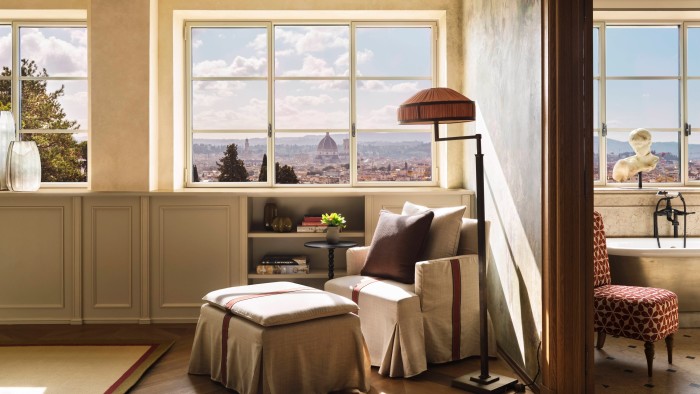Unlock the Editor’s Digest for free
Roula Khalaf, Editor of the FT, selects her favourite stories in this weekly newsletter.
Art, history and Andalusian style
New to the Seville scene, just in time for Andalusia’s semana santa festivals, is Casa del Limonero, a design-forward concept within an extraordinary building. The barrio Santa Cruz landmark has a history reaching back as far as the city’s – to when Seville was Hispalis (for the ancient Romans), then Ishbiliyah (for the caliphate that conquered it in AD711) before becoming part of Castile in the 13th century. The Casa retains traces of almost every era: ancient paving stones, Nasrid maiolica tiles in the flowering courtyards and 15th-century coffered ceilings.
Inside, a different story’s being told: each of the 14 rooms and suites is whimsically themed; decor ranges from original carved mantelpieces to 17th-century Venetian mirrors, a 900-year-old column base and a wildly imaginative headboard crafted by a French metalsmith. The art is serious, with works by Joana Vasconcelos and Malick Sidibé in the careful mix. The top-floor suite is blessed with both light and old-town views.
Alpine minimalism (but make it cosy) in Switzerland
Europe’s finest skiing destinations have been doing double duty as summer retreats in recent years. In St Moritz, one of the grandest old dames of them all is showing an intriguing new face to the world. In January Badrutt’s Palace debuted 25 new suites in their own ultra-contemporary wing, the 129-year-old hotel’s first significant renovation in a century.
Designed by Antonio Citterio and Patricia Viel – the Italian architects who have brought extreme rigour to everything from the Public Plaza at 1221 Avenue of the Americas (part of Rockefeller Center) to Bvlgari hotels across the world – Badrutt’s new Serlas wing is a separate proposition to the Palace in most every aesthetic way. Where the latter is damasks and crystal chandeliers, marble accents and heavy drapes, the Serlas suites dispense with all but the most austere ornamentation, letting the quality of the materials, from the planed oak floors and travertine baths to the Loro Piana upholstery, do the talking.
Polished Arcadia, in Italy’s renaissance capital
It’s not properly in central Florence, nor is it properly in Fiesole, up the hill and out of town. Sounds like a detraction, but it’s an asset – one of several that Collegio alla Querce, the first Italian property to fly the flag of US-based Auberge hospitality, brings to Italy’s most (over)loved city. The Collegio – made up of three 16th-century buildings, surrounded by acres of lawns and parterre gardens – was once one of Florence’s most prestigious boys’ schools. This accounts for the chapel and theatre (plans are reportedly afoot to stage cabaret dinners curated by Fondazione Mascarade, whose English founders have made live opera and jazz buzzy again here).
The 83 rooms and suites overlook cypress-covered slopes in one direction, or the centro storico in the other. A handful of suites have Forster-worthy views of the Duomo from frescoed interiors and enormous terraces. The breakfast in the airy limonaia restaurant, La Gamella, is a thing of wonder; the poolside Cafe Focolare has an alfresco pizza oven and tables in its own olive grove; the Conservatorio, with its cascades of blooms and cosy alcoves, aims to be a day-to-night social heart for guests and locals. Auberge doesn’t miss a trick on amenities, so guests will want for nothing. And if a bit of patina has gone missing in the pursuit of perfection, few would contest the probability that a chaise next to the hillside pool is going to be one of the better places to be in town when summer arrives.
Channelling nostalgia – and chic – by the sea in Tuscany
Pensione America claims to be the first hotel in the posh Tuscan beach town of Forte dei Marmi; built as a private home in the 1890s and converted to a hostelry in the 1920s by its second owners, it’s entering a third phase of existence as one of the Leading Hotels of the World.
Niece and aunt owners Sara and Elena Maestrelli grew up summering here and have channelled some nice hits of Forte’s midcentury nostalgia days while also hitting all their trend marks with the rattan beds, Sicilian ceramics and Santa Maria Novella amenities in the 18 suites. There’s a two-storey villetta that sleeps five, and full access to Bagno Assunta beach club down the road for all guests.
@mariashollenbarger
Read the full article here

